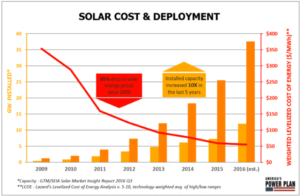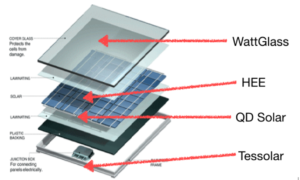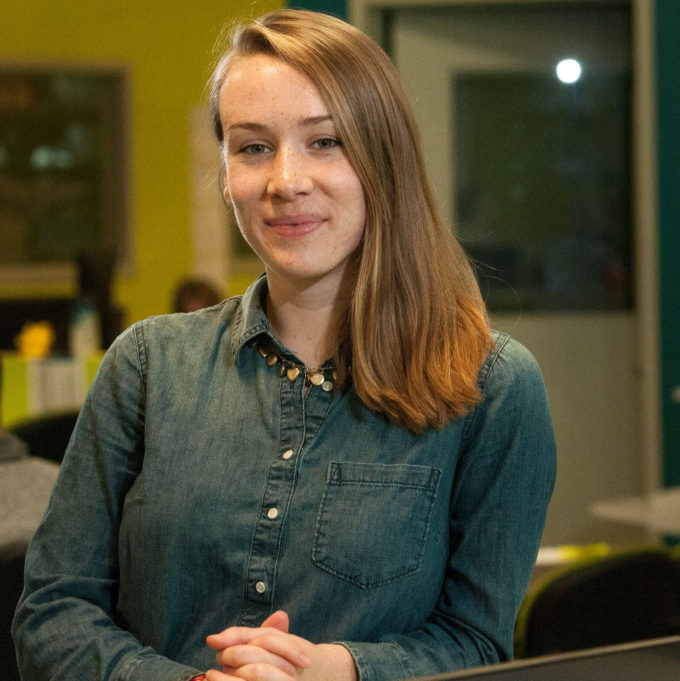By Katie MacDonald, Director of Strategic Partnerships, Greentown Labs
While we were away on holiday break sipping hot chocolate and warming ourselves by ovens and fireplaces something fantastic happened in the solar industry. According to a recent report by Lazard on the levelized cost of energy for conventional and renewable energy, renewables are now the cheapest source of electricity available. [INSERT CELEBRATORY CHEER!]
As we reflect on 2016 and ramp up for a busy 2017, I’d like to explore how we’ve gotten to this historic point as an industry and elaborate on how Greentown Labs is committed to supporting technology that enables a decrease in the levelized cost of energy (LCOE) for solar PV.
So, what’s that LCOE all about?
LCOE is the ratio of the total life cycle cost of a power generating asset over the total energy produced by that asset over its lifetime, in $/kWh. LCOE allows for accurate comparison of different types of generating technologies (e.g. solar, wind, coal) to assess their relative competitiveness.
Over the last decade we have seen a swift decline in the LCOE of solar and a spike in installed capacity:

What’s Causing these Trends?
- Federal subsidies from the Solar Investment Tax Credit (ITC) which has existed since the 2005 Energy Policy Act was written into law to enable commercial and residential solar customers to save dollar for dollar on their income taxes which makes solar far more affordable. These tax credits have been extended via the 2015 Omnibus Appropriations Act to apply to all projects which have ‘commenced’ before 2023.
- Financing tools have enabled customers who cannot afford the capital expenditure of installing solar to defer payment or distribute the financing responsibility. Some such programs include grants and technical assistance, on-bill financing and/or recovery, place-based investments, property assessed clean energy programs, community financing solutions, green banks and other creative measures from government, private and community institutions intent on supporting solar adoption financially.
- Installation costs have become cheaper as a result of demand driving down the price of installation and increasing the commercial institutions providing installation as a service across the country.
- Manufacturing costs have decreased to the point that some manufacturers may be selling at a loss as the demand for solar PV has risen demanding economies of scale for mass manufacturing.
- Increased efficiency of traditional silicon PV driven by technology has increased the overall energy conversion rate of PV from 11% in 2000 to 15% to 20% today. This incremental improvement in conversion rate annually (approximately 0.3% a year according to Photon International) has meant higher energy output per watt of solar.
Let’s Keep the Momentum with Innovation
Technology plays a critical role in increasing efficiency of solar PV through innovative materials. Understanding this reality and the opportunity to further decrease the LCOE of solar to increase solar market penetration, Greentown Labs launched its first solar materials challenge program in 2016 called ‘SunRISE’ sponsored by Royal DSM and in partnership with Fraunhofer’s TechBridge Program.
In collaboration with our partners, we released an RFA for companies addressing the following areas with solar materials technology:
- Increasing module conversion efficiency
- Improving module durability
- Reducing maintenance costs
- Reducing the overall cost of module materials per unit energy produced over lifetime, both in new and current PV installations
Applicants were evaluated for their ability to decrease LCOE of solar with their technologies and we accepted four companies into our program: u
- HEE Solar (Dallas, TX) – is developing perovskite photovoltaic technology, made stable to achieve long lifetimes.
- QD Solar (Toronto, Canada) – is developing next generation photovoltaic cells using colloidal quantum dot cell technology.
- Tessolar (Cambridge, MA) – has developed a novel module design that targets reduction in module and balance of system costs.
- WattGlass Inc. (Fayetville, AR) – is commercializing the next generation of anti-reflective glass coatings that also have self-cleaning and anti-fogging properties.
Here is a look at where the SunRISE startups technologies fit into the ‘solar sandwich’:

After program acceptance, we worked with CEO’s and team members from each of the companies to accelerate their products toward the solar market. Our approach combined access to more than sixty industry experts, eighty hours of training, connection to the network and resources available to our Greentown Labs community, and the opportunity to work with the team at Royal DSM to de-risk products and learn how corporate innovation programs and partnerships can catalyze commercialization.
During the six-month program, the startups reached notable milestones with their prototype testing, partnerships, IP protection and fundraising. Tessolar and WattGlass won grants from the DOE SunShot program, a competitive grant program which supports “solar energy adoption by making solar energy affordable for all Americans through research and development efforts in collaboration with public and private partners,” HEE and QD Solar made progress on their technical testing and fundraising and DSM moved forward on conversations with the startups about their potential for investment.
“We weren’t ready for investment and now we are” said WattGlass CEO, Corey Thompson, at the conclusion of the 2016 SunRISE program. “The value of being at Greentown has been huge.”
In order to enable the success of solar in developed markets, we must invest in new technology that can deliver higher efficiencies and lower costs than today’s standard silicon. As manufacturers seek to differentiate their product by delivering better performance for the same or lower cost, Greentown Labs will continue to support the solar industry as we collectively work toward even more striking successes in 2017 and beyond. Stay tuned for more solar announcements from our team in the coming months!
Onwards & Upwards,

Katie MacDonald
Director of Strategic Partnerships


